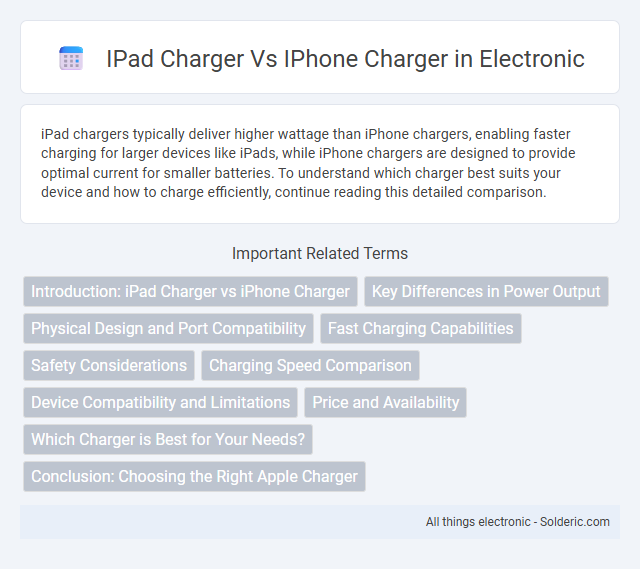iPad chargers typically deliver higher wattage than iPhone chargers, enabling faster charging for larger devices like iPads, while iPhone chargers are designed to provide optimal current for smaller batteries. To understand which charger best suits your device and how to charge efficiently, continue reading this detailed comparison.
Comparison Table
| Feature | iPad Charger | iPhone Charger |
|---|---|---|
| Wattage | Typically 20W to 30W | Typically 5W to 20W |
| Charging Speed | Faster (supports fast charging) | Slower compared to iPad charger |
| Connector Type | USB-C (latest models) | Lightning or USB-C (newer models) |
| Compatibility | Optimized for iPad models (iPad Pro, Air, etc.) | Optimized for iPhone models |
| Price | Higher priced due to higher wattage | Lower priced |
Introduction: iPad Charger vs iPhone Charger
iPad chargers typically provide higher wattage output, ranging from 10W to 30W, to support faster charging and power demands of larger batteries compared to iPhone chargers which usually offer 5W to 20W. The difference in power output affects charging speed, with iPads requiring more robust chargers to maintain optimal charging efficiency. Both devices use USB Power Delivery technology, but compatibility and optimal charging depend on matching device requirements with the charger's wattage and cable type.
Key Differences in Power Output
The iPad charger typically delivers a higher power output, usually around 18 to 20 watts, compared to the iPhone charger's standard 5 to 12 watts. This increased wattage allows the iPad charger to charge larger batteries more efficiently and at a faster rate. Using an iPad charger for an iPhone can speed up charging times without damaging the device since iPhones are designed to regulate incoming power safely.
Physical Design and Port Compatibility
iPad chargers typically feature a larger power adapter with higher wattage, designed to handle the increased charging demands of iPads, compared to the more compact and lower wattage iPhone chargers. Both chargers often use a USB-C to Lightning cable for recent models, but older iPhone chargers may include USB-A ports, affecting compatibility with newer iPad cables. The physical size and port type differences impact charging efficiency and device compatibility, with iPad chargers offering faster charging for compatible devices due to their higher output and USB-C interface.
Fast Charging Capabilities
iPad chargers typically offer higher wattage, such as 20W or more, enabling faster charging speeds compared to standard iPhone chargers, which often range from 5W to 18W. The increased power output of iPad chargers supports rapid battery replenishment for compatible iPhone models, especially those supporting USB Power Delivery (USB-PD) fast charging protocols. Using an iPad charger with an iPhone can significantly reduce charging time, maximizing efficiency without compromising device safety.
Safety Considerations
iPad chargers typically deliver higher wattage, often 20W or more, requiring safety features like overcurrent protection and temperature control to prevent overheating. iPhone chargers, usually ranging from 5W to 20W, incorporate built-in safeguards such as short-circuit prevention and voltage regulation for device compatibility. Using the appropriate charger for each device minimizes risks of battery damage and electrical hazards, ensuring optimal safety.
Charging Speed Comparison
iPad chargers typically offer higher wattage, ranging from 18W to 30W or more, enabling faster charging compared to standard iPhone chargers that usually provide 5W to 20W. The increased output of iPad chargers supports quicker power delivery, reducing overall charging time for compatible iPhone models that can handle higher wattage. However, charging speeds also depend on device optimization and cable quality, with iPhones benefiting most from chargers that meet their specific voltage and current requirements.
Device Compatibility and Limitations
iPad chargers typically deliver higher wattage, usually around 20-30W, providing faster charging for iPads and compatible iPhones, while iPhone chargers often range from 5W to 20W depending on the model. Using an iPad charger on an iPhone is safe and can speed up charging, but using an iPhone charger on an iPad may result in slower or insufficient charging performance due to lower power output. Device compatibility depends on the USB Power Delivery (PD) protocol, which both chargers generally support, but iPad chargers are optimized for larger battery capacities found in iPads.
Price and Availability
iPad chargers typically cost more than iPhone chargers due to their higher wattage and power delivery capabilities, ranging from $19 to $29 compared to $15 to $25 for iPhone chargers. Availability for both chargers is widespread across official Apple stores, authorized retailers, and online marketplaces, ensuring you can easily find a compatible charger regardless of your device. Choosing the right charger depends on your device's power requirements, with iPad chargers offering faster charging but at a higher price point.
Which Charger is Best for Your Needs?
Choosing the best charger for your needs depends on device compatibility and charging speed; iPad chargers generally offer higher wattage, enabling faster charging for iPads and compatible iPhones. While iPhone chargers typically provide lower wattage suited for smaller batteries, using an iPad charger for your iPhone can safely expedite the charging process without damaging the battery. Consider your device model and charging habits to select a charger that balances efficiency and portability for your everyday use.
Conclusion: Choosing the Right Apple Charger
Selecting the right Apple charger depends on device compatibility and charging speed requirements, with iPad chargers typically delivering higher wattage for faster charging compared to iPhone chargers. Using an iPad charger for an iPhone is safe and can reduce charging time, while an iPhone charger will charge an iPad more slowly due to lower power output. Prioritize chargers that support USB Power Delivery (USB-PD) and match the wattage recommendations for optimal battery health and performance.
iPad charger vs iPhone charger Infographic

 solderic.com
solderic.com